 Marco Berti & Nina Stemme in the Finale to Act III of Turandot (Met Opera)
Marco Berti & Nina Stemme in the Finale to Act III of Turandot (Met Opera)Two for the Price of One
The January 30, 2016 broadcast of Puccini’s Turandot featured Swedish soprano Nina Stemme in the stratospheric title part, Italian tenor Marco Berti as the Unknown Prince Calaf, Romanian soprano Anita Hartig as the slave girl Liu, and Ukrainian bass-baritone Alexander Tsymbalyuk as Timur. The ministers Ping, Pang, and Pong were taken, respectively, by baritone Dwayne Croft, and tenors Tony Stevenson and Eduardo Valdes, with a third tenor, Ronald Naldi, as the aged Emperor Altoum. Baritone David Crawford sang the minor role of the Mandarin. The conductor for this Saturday afternoon performance was Paolo Carignani, with chorus master David Palumbo leading the forces of the mighty Met Opera Chorus.
This revival of Franco Zeffirelli’s lavishly conceived and cumbersomely executed production (Zeffirelli also served as set designer) was supervised by David Kneuss, with choreography by Chiang Ching. Due to German tenor Jonas Kaufmann’s cancellation as the Chevalier des Grieux in the new Richard Eyre production of Puccini’s Manon Lescaut, the originally scheduled Roberto Alagna, who was to have sung Canio in the revival of Leoncavallo’s Pagliacci, stepped in at the eleventh hour to take over for the ailing Kaufmann. In the spirit of a late-inning pinch hitter, Signor Berti offered to sing Canio as well as Calaf — that’s two C’s for the price of one — so that Monsieur Alagna could continue to add luster to the program (and save the Met’s heavily advertised Manon Lescaut production from box-office oblivion).
The Pagliacci performance in question was heard, along with its companion piece, Mascagni’s Cavalleria Rusticana, in the following week’s transmission of February 6. The cast for Cav included Lithuanian soprano Violeta Urmana as Santuzza, Korean tenor Yonghoon Lee as Turiddu, Italian baritone Ambrogio Maestri as Alfio, American mezzo-soprano Jane Bunnell as Mamma Lucia, and Italian-American mezzo Ginger Costa-Jackson as Lola. For Pag, we had Marco Berti as Canio, Italian soprano Barbara Frittoli as Nedda, Georgian baritone George Gagnidze as Tonio, Russian baritone Alexey Lavrov as Silvio, and Greenville, South Carolina native Tony Stevenson as Beppe. Fabio Luisi, the Met’s outgoing principal conductor, was in command of the orchestra.
Hearing Berti in two back-to-back broadcasts, and in two of the cornerstones of the Italian spinto repertoire, was revelatory in that one could gauge where he felt most comfortable, and where he still needed work. Without batting an eye, it was obvious from the start that Signor Berti fit in better with the more realistic Pagliacci milieu than in Turandot’s patently fairy-tale realm. We’ll discuss his efforts as they arrive. Right now, however, let’s get a few words in about the supporting players in each work.
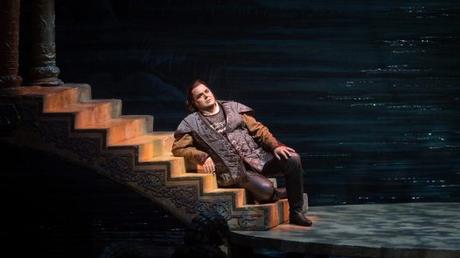
Conductor Paolo Carignani took a faster than usual pace in Turandot, which moved the opera along at a nice, even clip. It made for a perfunctory reading at times, but taken as a whole the feeling was one of suppressed emotion, which was only let lose at the proper moment. Puccini was a master of such musical phrasing, in fact the shorter the better. To wit, he gave the chorus his most elaborate, most soaring music, backed by full orchestra with organ, which gave each of the opera’s three acts a deeply sonorous quality.
In many respects, the chorus is the most prominent element in the work. The crowd (la folla in Italian) or mob mentality drives the bulk of the action. They comment on the course of the drama; they voice their concerns and cry out in rage, in pain, and in excitation as the need arises. It would be fair, then, to compare their part to that of Mussorgsky’s Boris Godunov, where the chorus represents, and are superbly characterized, as the oppressed Russian people.
As expected, Donald Palumbo’s Met Chorus unleashed a torrent of sound throughout, earning justifiable applause from every corner of the house for the thrilling volume they emitted. At the start, David Crawford’s steely Mandarin made one sit up and take notice, which is the whole purpose of having a lustrous-voiced singer in the part. The Mandarin serves a similar purpose as the Herald in Wagner’s Lohengrin: dramatically inert, but vocally imperative.
Anita Hartig performed well as Liu. She had a nice, quick vibrato sound, which she skillfully employed throughout the afternoon. Her softly nuanced high notes in the two scenes in Act I made the most impact: “Perchè un di … nella reggia, mi hai sorriso” (“Because one day … at court, you smiled at me”) is Liu’s explanation to the Unknown Prince (Calaf in disguise) as to why she suffered exile and agony in caring for his father, the deposed Tatar king, Timur.
“Signore ascolta” (“Listen, sir”) was deeply felt, a plea for understanding in her attempt to dissuade the enamored Unknown Prince from his reckless pursuit of the Princess Turandot. Taking deep breaths to convey Liu’s anguish was a big factor in Hartig’s success in this piece. Signor Berti’s response, “Non piangere Liu” (“Liu, don’t weep”), was restrained in its first half, if inelegantly conveyed. A native Italian and one overly familiar with the words, Berti was capable of expressing a good deal of meaning behind the text, if a shade or two loudly over the airwaves. I sensed a bit of finagling with the balances on the radio station I was listening to. Sorry, folks, but the guy does have a huge voice — and he knew how to use it, too!
Ms. Hartig’s death scene in Act III (“Tu che di gel sei cinta” – “You who are made of ice”) was movingly uttered, her acting gaining strength and force prior to her plunging the dagger into her breast. Liu’s self-sacrifice is what melts the ice-cold Princess’ heart, which gives way to love in the opera’s finale. Alexander Tsymbalyuk, too, had a quick vibrato, with a voice resembling that of the Greek basso Nicola Zaccaria, who appeared with and recorded alongside the legendary Maria Callas. He was most effectual in the brief arioso after Liu’s suicide, where the blind monarch stumbles along next to her lifeless body (much like Shakespeare’s King Lear, it must be noted), guiding her spirit on to the next world. Both he and Hartig gave sincere performances that earned the audience’s approval come curtain time.
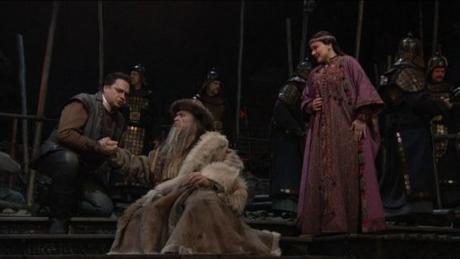
In the Act II Trio of the Masks, Dwayne Croft as Ping ran aground on the high tessitura of his part, but his supple singing with Tony Stevenson (Pang) and Eduardo Valdes (Pong) was most pleasurable to the ear at the phrase “Tutto cinto di bambù” (“All covered with bamboo”). During the intermission, it was mentioned that it takes singing this trio over 21 times together before the artists can get it under their belt. Incidentally, this scene, coming as it does before the Riddle episode, is one of Puccini’s richest and most melodious creations — unfortunately, standard cuts were applied, much to my chagrin.
I’ve mentioned this issue before. Why the Met continues to slice this sequence is beyond reason. The cuts hardly amount to a few extra minutes of musical continuity, so excising them seems pointless. General Manager Peter Gelb, please consider reinstating them the next time Turandot is presented (hopefully, in a newer and fuller production, which incorporates Alfano’s original ending). How many more pleas will it take to get through to the Met’s management? Ira Siff, the broadcast’s co-host and commentator, agrees this is his favorite part in the opera (mine, too). Well, then, what are we waiting for? Most, if not all, of the modern recordings feature these extended lines, so why not hear them in live performance? It’s one of those unsolved riddles associated with this piece.
Losing Your Head Over Turandot
And speaking of big, strong voices, Nina Stemme’s Turandot stressed more than overt vocalism. Following in the illustrious footsteps of fellow Swede, the iron-lunged Wagnerian Birgit Nilsson, in one of her specialty roles can be an intimidating proposition for any singer. Be that as it may, Ms. Stemme, who we’ll be reviewing in the coming months as Strauss’ Elektra, gave the title role her considerable all. Taking the approach that a little less can mean a lot more in terms of character development, Stemme portrayed a more vulnerable, even womanly Principessa than the norm for this monumental assignment.
Beginning demurely with her Act II narration, “In questa reggia” (“In this kingdom”) where she relates the rape and murder of her ancestor, Princess Lo-u-Ling, Stemme expanded the vocal line and range of her voice as necessitated by the dictates of the plot. She made explicit points in the text, stressing the words “Un uomo come te, come te: straniero” (“A man such as you, such as you: stranger” – note: straniero can also mean “foreigner”) with specificity and purpose, placing the blame on men such as he, who come into her kingdom seeking love and passion, yet end up raping and pillaging. This is the raison d’être for her being, the sole purpose of all the beheadings after each pretender to her throne fails to answer her riddles.
Stemme joined voices with Berti in the climax, “Gli enigmi sono tre, l’una è la vita!” (“The riddles are three, one of them is life!”). Singing a tad sharp, Berti got to pull out his high C, as did Stemme, but did not prolong it (a dramatic choice on his part). An otherwise excellent Altoum by Ronald Naldi added spice to the proceedings. As for Berti, he took the optional C in alt on the phrase “Ti volgio tutto ardente d’amor” (“I’ll take you in ardent love!”), which, regrettably, was none too convincing. You can compare its execution to your having been hit on the head with a trowel, which destroyed any romantic illusions the line was meant to convey. The succeeding portion, “Il mio nome non sai; dimmi il mio nome” (“My name you do not know; then tell me my name”) came off better, in the best Pavarotti-like tradition, to cite a much lamented singer who knew how to deliver the goods, but within his own strictly lyrical means.
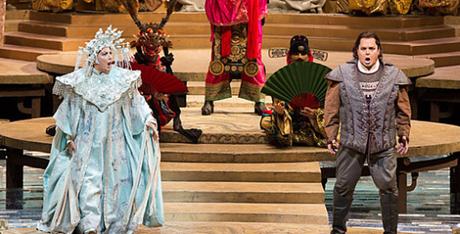
There has only been one other artist whose traversal of the killer role of Turandot has moved me as much as Stemme did here: i.e., the late Joan Sutherland in the classic Decca/London recording from 1972, with Luciano Pavarotti, Montserrat Caballé, Nicolai Ghiaurov, and Zubin Mehta conducting. Her understated way with the text and the manner in which Sutherland held her voice back until coaxed into action by the thrilling sound of a young Pavarotti, along with his melting of her heart in the penultimate scene, were re-captured (for the most part) in Nina’s potent re-enactment. It’s a minor quibble to have to complain about her less-than-perfect Italian (a lot better than mine, I assure you), but Madame Stemme came through covered in glory. She may not have dislodged Nilsson from Turandot’s throne, but she came awfully close.
As formidable a challenge as the part of Turandot may have seemed, in reality it’s a relatively short one. She puts in a visual appearance in Act I (normally done by a stand-in), and is only heard during the latter half of Act II, scene ii, in the so-termed Riddle Scene. She does not make her presence felt again until after Calaf has delivered “Nessun dorma” in Act III; and after the three ministers’ failed attempts to pry the secret of his name from the uncooperative Unknown Prince. Turandot falls silent during Liu’s torture and subsequent death. She nary makes a sound until the crowd has completely left the stage, which leaves Calaf to face and berate her as the “princess of death,” and (horror of horrors!) threaten to place his “throbbing mouth on hers.” Whew, wipe my brow with a handkerchief!
What some singers wouldn’t do to deliver on a line like that! Still, of all Puccini’s love duets between tenor and soprano, this was the only one the composer did not have a personal hand in. In truth, he hardly wrote a note of this sequence. As we know from previous posts, the job of completing the unfinished Turandot was given to a minor verismo composer named Franco Alfano, with much of this final “clash of the titans,” as well as the last choral episode, reworked and reshuffled by Toscanini, who conducted the premiere.
There will always be controversy surrounding this final sequence. For instance, was it Calaf’s impassioned kiss that awakens the princess from her “slumber,” or was it Liu’s untimely death and Timur’s lament for her passing that convinces Turandot to treat her suitors (and the “Popolo di Pekino,” or “People of Peking”) more humanely? Probably a bit of both: if the Liu in question happens to be Ms. Hartig, or the creamy-voiced Madame Caballé, whose slave girl is one of the loveliest on records, then our vote goes to her.
Laugh, Clowns, Laugh!
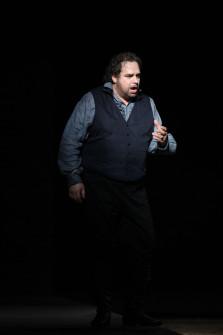
It helps, of course, if the Unknown Prince puts on a show of his own. Of all the lead parts in the Puccini canon for tenor, this one has the possibility of taking the cake every time — that is, if the artist is fully up to the task. In my day, such talents as Mario Del Monaco, Franco Corelli, Richard Tucker, Plácido Domingo, James McCracken, José Carreras, Giuseppe Giacomini, Ermanno Mauro, Vladimir Popov, Nicola Martinucci, and others carried the day with comparable ease.
A large voice and clarion delivery can also stir audiences like nothing else. But that’s only the start of it. Tenors with less substantial vocal equipment — I’m thinking of Jussi Bjoerling in the RCA Victor version with Nilsson and Renata Tebaldi — can persuade listeners with their ardent timbre alone.
In the past, Berti’s thick, beefy tone has been an asset in such serviceable assignments as Manrico in Il Trovatore, Radames in Aida, or Cavaradossi in Tosca. Here, he dived headlong into the meatier aspects of Calaf’s musings. This was straightforward, dramatic singing where Berti’s stentorian voice was hurled into the Met’s auditorium for all to hear. I must admit this was an exciting, even thrilling sound, one not heard at the Met since the halcyon days of Del Monaco, Corelli, and Tucker (for background information on these fabulous singers, see the following link: https://josmarlopes.wordpress.com/2012/07/29/three-titanic-tenors-del-monaco-corelli-and-tucker/).
For all its volume and heft, I missed the Unknown Prince’s more reflective side in Berti’s assumption of this role. In Act III, for instance, he could have opted to caress the opening lines of “Nessun dorma” (“No one sleeps”) in generous proportion to his voice. Berti handled the middle portion well enough, though not as musically sound as, say, tenor Mario Filippeschi did in his recording of the piece. Filippeschi, who had much better technical skills all around, easily encompassed the heroic aspects of the part, along with the tricky tessitura with its emphasis on the passaggio (similar, in many respects, to Cavaradossi’s “E lucevan le stelle” and the earlier “Recondita armonia,” from Tosca).
Surprisingly, for all the sound and fury hinted at earlier on, Berti’s B flat — the one with the infamous fermata on the word vincerò (“I will win”), allowing the tenor to hold on to the note for dear life — was cut short for some reason. And try as he might, Berti could not replicate the sweetness and lyricism that either Bjoerling or Pavarotti could bring to the number at this point. Consequently, tenorial warmth was generally lacking here.
As the broadcast Canio in Pagliacci, Berti pulverized the listener into submission. To be honest, his was an unsubtle performance, but a highly effective one. Despite the deficit above, the important thing was that it moved me, mostly at “Ridi, Pagliaccio” and the stirring finale. Comparing Berti to the previously mentioned Filippeschi, one must admit to a preference for the latter singer. Filippeschi had a solidity and security on top, along with the fullness and steadiness of tone, blended with remarkable breath control, musicianship, a rock-solid technique, and a caressing line that betrayed little effort.
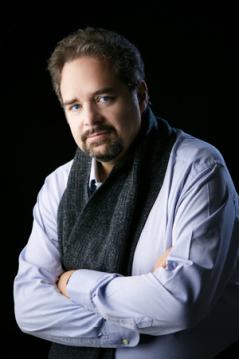
The part of Canio does not reach up to high C, but is somewhere in the middle A and B departments. Sustaining of the line, using the voice as the instrument of the clown’s despair, acting with the voice, expressing sorrow through the words, and emphasizing the poetry inherent in Leoncavallo’s text (which he himself wrote)— all these are what make Canio stand out from the rest of the characters, and what can distinguish a great artist from the merely adequate. Berti is on the right path, but more guidance and thought is required. Sheer volume is fine for what it’s worth, but more is demanded in this quintessential verismo role.
As Tonio, George Gagnidze was a rough and tumble antagonist, and indicative of director David McVicar’s concept of the part as a vaudeville standup comic. His Prologue was a blowout, bludgeoning the beauty of the text expect where Gagnidze’s expansive final phrase of “E voi, piuttosto” was spun. He went all the way up to the unwritten A-flat, and ended on a final G. My thought was, he made it this far, and nothing more after that. Barbara Frittoli’s La Strada-esque Nedda (a Fellini heroine in every way), along with Sergey Lavrov’s Silvio, made the best impression with their long, languorous love duet. Tony Stevenson was a smoothly voiced Beppe, while Berti earned kudos from the audience for his altogether mesmerizing play-with-the-play acting and singing, the verisimilitude of which leads Canio to murder his wife and her lover for real.
In Cavalleria, none of the singers were outstanding, however tenor Yonghoon Lee continues to impress with his suavely enunciated, expressively committed Turiddu. The large, economy-sized Ambrogio Maestri was wasted in the brief part of the teamster Alfio. His Italian diction, though, was beautifully enunciated and a continuing joy to listen to even in this minor assignment. That is about the best I can say for his contribution.
What I can say is that maestro Fabio Luisi continues to outdo his own excellent contribution by shaping both Cav and Pag in as gorgeous a fashion as I’ve ever heard these two works. Rarely have the strings and woodwinds sounded so wonderfully well together: they sang, they soared, they did everything but weep (and for a moment, I thought did THAT, too, during the lovely Intermezzo in Cavalleria). I raved about his conducting when this production was new (and especially in Berlioz’s Les Troyens a few years ago). Ergo, I will continue to praise his efforts to the four winds.
It’s a shame that maestro Luisi was passed over for the recently vacated position of Met musical director. Now that James Levine’s successor has been named (the winner was French-Canadian conductor Yannick Nézet-Séguin, a wise choice), Luisi felt that his services would be better appreciated elsewhere, possibly at the Zurich Opera.
The news is he will be leaving his post as principal conductor of the Metropolitan Opera Orchestra as of the 2016-2017 Season.
We wish him buona fortuna and Godspeed.
Copyright © 2016 by Josmar F. Lopes

